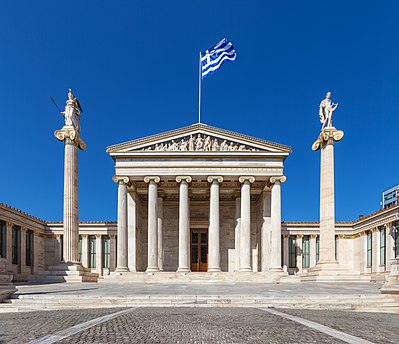Portal:European Union
Introduction
The European Union (EU) is a supranational political and economic union of 27 member states that are located primarily in Europe. The Union has a total area of 4,233,255 km2 (1,634,469 sq mi) and an estimated total population of over 449 million. The EU has often been described as a sui generis political entity combining the characteristics of both a federation and a confederation. Containing 5.8% of the world population in 2020, EU member states generated a nominal gross domestic product (GDP) of around US$16.6 trillion in 2022, constituting approximately one sixth of global nominal GDP. Additionally, all EU states except Bulgaria have a very high Human Development Index according to the United Nations Development Programme. Its cornerstone, the Customs Union, paved the way to establishing an internal single market based on standardised legal framework and legislation that applies in all member states in those matters, and only those matters, where the states have agreed to act as one. EU policies aim to ensure the free movement of people, goods, services and capital within the internal market; enact legislation in justice and home affairs; and maintain common policies on trade, agriculture, fisheries and regional development. Passport controls have been abolished for travel within the Schengen Area. The eurozone is a group composed of the 20 EU member states that have fully implemented the economic and monetary union and use the euro currency. Through the Common Foreign and Security Policy, the union has developed a role in external relations and defence. It maintains permanent diplomatic missions throughout the world and represents itself at the United Nations, the World Trade Organization, the G7 and the G20. Due to its global influence, the European Union has been described by some scholars as an emerging superpower. In 2012, the EU was awarded the Nobel Peace Prize. The United Kingdom became the only member state to leave the EU, in 2020; ten countries are aspiring or negotiating to join it. (Full article...) Selected article The European Space Agency (ESA), established in 1975, is an inter-governmental organization dedicated to the exploration of space, currently with 20 member states. Its headquarters are in Paris, France. ESA has a staff of about 2,000 with an annual budget of about €4 billion in 2013. ESA's spaceport is the Centre Spatial Guyanais (Guyana Space Centre) in Kourou, French Guiana, a site chosen because it is close to the equator from which commercially important orbits are easier to access. During the 1990s ESA gained the position of market leader in commercial space launches and in recent years ESA has established itself as a major player in space exploration. ESA science missions are based at ESTEC in Noordwijk, Netherlands, Earth Observation missions at ESRIN in Frascati, Italy, ESA Mission Control (ESOC) is in Darmstadt, Germany, and the European Astronaut Centre (PACI), that trains astronauts for future missions is situated in Cologne, Germany. Selected picturePhotograph credit: Thomas Wolf The Academy of Athens is Greece's national academy and the highest research establishment in the country. Established on 18 March 1926, it operates under the supervision of the Ministry of Education and Religious Affairs.
This picture shows the main building of the Academy, a neoclassical building between Panepistimiou Street and Akadimias Street in the centre of Athens and one of the city's major landmarks. The building was designed as part of an architectural "trilogy" in 1859 by Danish architect Theophil Hansen, along with the University and the National Library. The Greek neoclassical sculptor Leonidas Drosis sculpted the principal multi-figure pediment sculpture, on the theme of the birth of Athena, based on a design by painter Carl Rahl. Two columns on either side of the portico feature statues of Athena on the left and Apollo on the right, also designed by Drosis.
Did you know?...that Monaco, San Marino, and Vatican City all mint their own euro coins, with their own national symbols on the back, despite not being EU members? Selected cityRome is the capital of Italy and of its region, called Lazio. It is located across the confluence of the Tiber and Aniene rivers. It was once the capital of the Roman Empire, the most powerful, largest and longest lasting empire of classical Western civilization. The Vatican, a sovereign enclave within Rome, is the seat of the Roman Catholic Church and the home of the Pope. Rome is the largest comune in Italy and it is also one of the largest European capital cities in land area, with an area of 1,285 square kilometers. Within the city limits, the population is about 2.5 million; almost 3.8 million live in the urbanised area of Rome, as represented by the province of Rome, making it second in population to Milan. With a gross domestic product of €97 billion in the year 2005, Rome produced 6.7% of Italy's GDP. General imagesThe following are images from various European Union-related articles on Wikipedia.
TopicsFeatured contentFeatured articles
Featured lists
Featured contentGood articles
CategoriesRelated portalsAssociated WikimediaThe following Wikimedia Foundation sister projects provide more on this subject:
Discover Wikipedia using portals |

































































